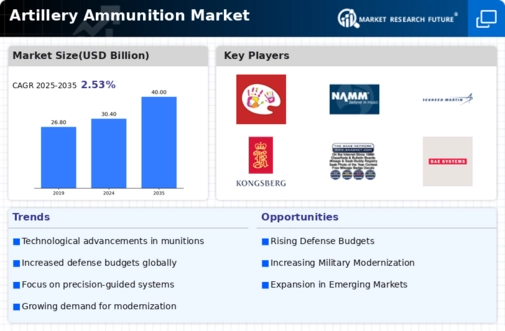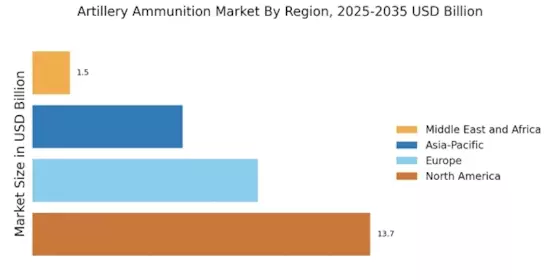Increased Defense Budgets
The escalation of defense budgets across various nations appears to be a primary driver for the Artillery Ammunition Market. Countries are prioritizing military modernization and enhancing their artillery capabilities, which necessitates a corresponding increase in ammunition procurement. For instance, recent reports indicate that defense spending in several regions has risen by approximately 5 to 10% annually, reflecting a commitment to bolster national security. This trend is likely to sustain demand for artillery ammunition, as military forces seek to maintain operational readiness and effectiveness. Furthermore, the Artillery Ammunition Market is expected to benefit from long-term contracts and partnerships between governments and defense contractors, ensuring a steady flow of orders and innovations in ammunition technology.
Technological Innovations
Technological innovations in artillery systems and ammunition types are poised to reshape the Artillery Ammunition Market. Advancements such as precision-guided munitions, smart artillery shells, and enhanced range capabilities are becoming increasingly prevalent. These innovations not only improve the effectiveness of artillery systems but also drive demand for specialized ammunition. The market is witnessing a shift towards more sophisticated and efficient munitions, which can significantly enhance operational outcomes. As military forces seek to leverage cutting-edge technology, the Artillery Ammunition Market is likely to experience growth driven by the integration of these advanced solutions into existing arsenals.
Emerging Military Conflicts
The emergence of military conflicts and tensions in various regions serves as a significant catalyst for the Artillery Ammunition Market. As nations engage in strategic posturing and military readiness, the demand for artillery ammunition is likely to surge. Recent geopolitical developments have underscored the necessity for enhanced artillery capabilities, prompting countries to invest in advanced munitions. For example, the ongoing conflicts in certain areas have led to increased military exercises and operational deployments, which in turn drive the need for artillery supplies. This heightened focus on preparedness may result in a sustained increase in procurement activities, thereby positively impacting the Artillery Ammunition Market in the foreseeable future.
Focus on Modern Warfare Strategies
The evolving nature of modern warfare strategies is driving changes in the Artillery Ammunition Market. Military doctrines are increasingly emphasizing the importance of artillery in combined arms operations, necessitating a reevaluation of ammunition requirements. As forces adapt to new combat environments, there is a growing emphasis on versatile and adaptable artillery systems. This shift is likely to result in increased demand for diverse types of ammunition, including those designed for urban warfare and asymmetric conflicts. Consequently, the Artillery Ammunition Market may witness a transformation in product offerings to meet the changing needs of contemporary military operations.
International Arms Trade Agreements
International arms trade agreements and collaborations among nations are influencing the dynamics of the Artillery Ammunition Market. Such agreements facilitate the exchange of military technology and ammunition, thereby expanding market opportunities for manufacturers. Countries engaged in defense partnerships often require compatible artillery systems and ammunition, leading to increased procurement activities. The establishment of joint ventures and cooperative programs can also enhance production capabilities and foster innovation within the industry. As nations seek to strengthen their military alliances, the Artillery Ammunition Market is expected to benefit from a more interconnected global defense landscape.


















Leave a Comment